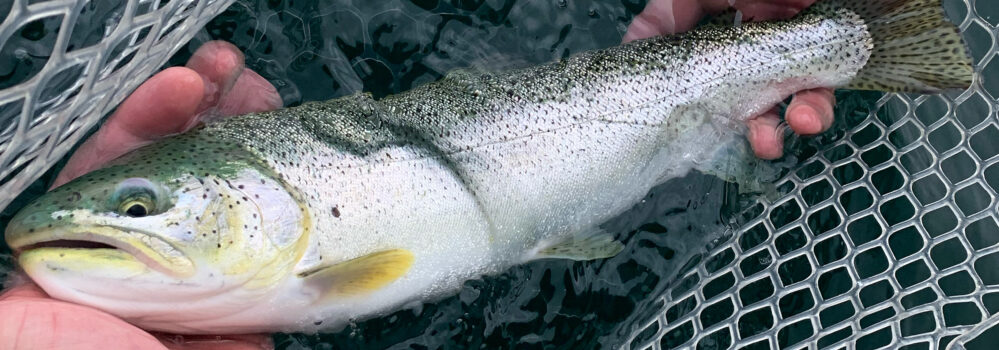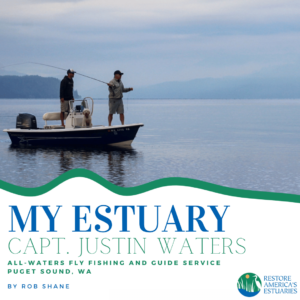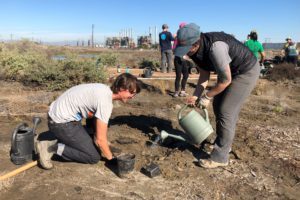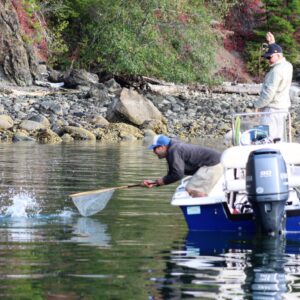
My Estuary: Captain Justin Waters

Searching for the Secrets of Puget Sound
Captain Justin Waters is a recreational fishing guide in Puget Sound. With a name like Waters, it’s almost like his fate was already decided for him. Whether you’re new to fly fishing, an experienced angler, or someone just looking for an enjoyable day on the water, Justin, and his team at All-Waters Fly Fishing and Guide Service, has you covered. Operating largely in the Hood Canal, Justin’s specialty is putting clients on large sea-run coastal cutthroat trout, salmon, and steelhead.
Originally from Florida’s Nature Coast, Justin found his way to the Pacific Northwest the way many anglers do – dreams of anadromous fish pulling at the end of his line beneath the canopy of the rainforest and glaciers of the Olympic Peninsula.
What started as a solo operation has now expanded to include multiple guides on staff and partnerships with local resorts for visiting anglers yearning for a chance to connect with the fish of a lifetime in the waters of Puget Sound. “When I first started, we were taking clients out on kayaks to fly fish for cutthroat and salmon,” said Justin. “Now, we’re launching our boats from the docks of Alderbrook Resort most of the year.”
Running a business came naturally to Justin, who has a degree in fisheries management and spent time guiding in the Yellowstone region and Alaska’s Bristol Bay, as well. “I really enjoy the marketing side of running a business – getting our name out there and meeting new people – that’s how the partnership with Alderbrook came about. I just walked in one morning and asked the manager if we could operate out of their docks.” This handshake agreement has turned into a 10-year partnership between the two companies.
The partnerships don’t stop at Alderbrook, though. Justin and his team are also active in the conservation community – speaking at club meetings and events, hosting trash cleanups, and working closely with restoration organizations, like the Hood Canal Salmon Enhancement Group and Trout Unlimited.
For Justin, it’s not enough to just enjoy the resource, giving back is just as important to his business.

Anadromous fish are as synonymous with the Pacific Northwest as Starbucks and the Space Needle. Salmon, steelhead (anadromous rainbow trout), and the previously mentioned coastal cutthroats are the lifeblood of the recreational and commercial fishing economy in Washington state. In fact, it’s rare to find another species that don’t rely on these fish in one or more ways. Orca whales’ main food source is salmon. Dead salmon wash ashore and provide nutrients to the soils of the rainforest after they’ve completed their spawning journeys. Even other fish rely on salmon – their eggs are an important meal for juvenile and adult trout.
In fact, that’s how Captain Waters finds many of his best fishing spots. “If you can track down the rivers that still have strong salmon runs, it’s rare not to find the cutthroat and other fish stacked up behind them, vacuuming up eggs and chasing smolt for an easy meal.”
Unfortunately, Pacific salmon in Puget Sound, and almost everywhere else along America’s Pacific coast, face an uphill battle.
The obstacles to salmon recovery in Washington are many. Hydropower dams block passage to native spawning grounds although they provide clean and affordable energy to millions of people. Development along the coasts to support cities like Seattle has impacted water quality while also providing critical economic centers for America’s tech, aviation, and shipping industries, as well as 4.1 million people. Hatcheries have inundated rivers with less fit salmon reducing the health and abundance of wild populations, but they also support commercial and recreational fisheries and meet tribal fishing obligations stated in federal treaties (for better or worse).
On top of all that, sea level is rising, Puget Sound and the Pacific Ocean are getting warmer and more acidic and rivers are running dry due to drought.
These obstacles are not easy, or cheap, to solve and they put serious pressure on business owners like Justin who depend on a healthy Puget Sound to make a living. Luckily, NOAA and other federal agencies are working hard to make progress on restoring what once was, and can still be, the most productive salmon fisheries in the Lower 48.
Restoration and Natural Infrastructure
Through the Bipartisan Infrastructure Law and Inflation Reduction Act, NOAA has committed $175 million to reconnect waterways with a focus on restoring healthy populations of native fish and other aquatic species in 2023. Another $85 million is available specifically for Tribes to undertake the same efforts. In 2022, NOAA administered more than $75 million through the same programs.
This, in addition to the great work of the Washington Department of Fish & Wildlife and the previously mentioned Salmon Enhancement Groups, is providing at least a glimmer of hope for a return to glory for the famous salmon runs of yesteryear. The solution, habitat restoration and reconnection, is the solution to recovering threatened and endangered salmon in the Puget Sound.

We now have a better understanding of the value of protecting and restoring coastal habitat, and communities too, thanks to a 2021 report from Restore America’s Estuaries. The Economic Value of America’s Estuaries produced a case study on the Snohomish Estuary, which sits across Puget Sound from Justin’s favorite fishing grounds in the Hood Canal, quantified the value of natural infrastructure for the region.
In this study, it was found that intact wetlands, connected rivers, and nature-based shorelines were worth an estimated total $1.7 million in flood reduction per 100-year flood event. When factoring in climate change, which includes more regular and devastating storms, that value could rise as high as $3.4 million. This figure only represents the value for damage to property, though, and does not include potential losses in revenue for businesses like Justin’s and many others.
The Snohomish Estuary, like all coastal wetlands, also plays a pivotal role in protecting us from the worst of climate change. Estuaries are great at storing and sequestering carbon deep in the murky soils beneath the sea floor. The 189-hectares of this estuary provide a potential benefit of $2.8 million.
Protecting wetlands and estuaries won’t be enough to bring back Chinook and coho salmon in the Snohomish watershed, though. We must take a proactive approach to restoring wetlands and rivers too.
One such project reconnected Qwuloot Estuary to the larger Snohomish system, restoring 350 acres of previously isolated floodplain. Led by the Tulalip Tribes of Washington and local partners with funding from the NOAA Restoration Center, the $5.7 million restoration project removed an earthen barrier and reconnected 16 miles of spawning and rearing habitat for threatened Chinook salmon and other anadromous fish.
Another project is also in the works, thanks to funding from BIL. In 2023, Snohomish County received $2.8 million to habitat and floodplains in the basin at Thomas’ Eddy, Shinglebolt Slough, and Chinook Marsh. This project will restore 17 miles of shoreline habitat and 1,200 acres of estuary and riverine floodplain function.
The future is murky

Even as investments in restoration ramp up, climate change is still knocking on the door. Despite our best efforts to improve and protect natural infrastructure, sea level rise and warming oceans have the potential to nullify all of our great work. And the impacts are already happening.
In our conversation, Justin told me how ten years ago when he first started fishing the Hood Canal, you could see the glaciers of the Olympic Peninsula from his boat. Now, those views are just a memory. Not to mention the regular, even expected, cancellation of recreational fishing seasons on some of the Northwest’s most famous rivers due to low returns of spawning salmon.
He is optimistic, though, that through partnerships and stewardship, we can save our fisheries and the estuaries they rely on – not just for the sake of his business, but with the hope that his young children will also be able to experience the same fishing opportunities he’s grown to love and rely on.
Thank you, Captain Justin Waters, for sharing your story with us. If you find yourself looking for a fishing adventure in Washington’s Puget Sound, we encourage you to consider All-Waters Fishing and Guide Service for your next trip.
Rob Shane is the Sr. Communications Manager for Restore America’s Estuaries. He is based in Alexandria, VA but has spent more than a few days fishing for salmon and steelhead on the Olympic Peninsula.
